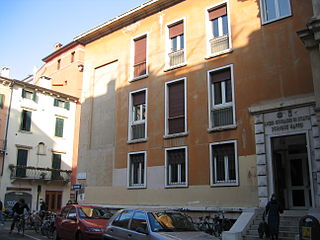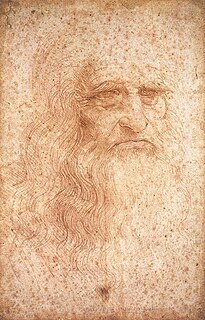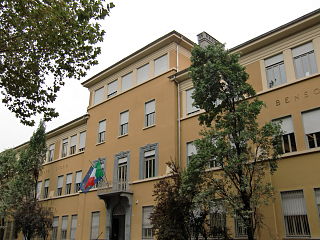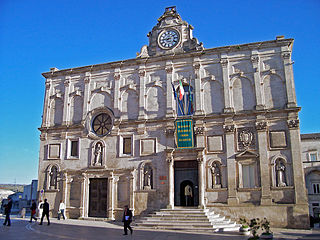
Matera is a city in the region of Basilicata, in Southern Italy.

EUR is a residential and business district in Rome, Italy, part of the Municipio IX.

The Cimitero Monumentale[tʃimiˈtɛːro monumenˈtaːle] is one of the two largest cemeteries in Milan, Italy, the other one being the Cimitero Maggiore. It is noted for the abundance of artistic tombs and monuments.

Giovanni Placido Agostino Pascoli was an Italian poet, classical scholar and an emblematic figure of Italian literature in the late nineteenth century. He was, together with Gabriele D'Annunzio, the greatest Italian decadent poet.

Liceo scientifico is a type of secondary school in Italy. It is designed to give students the skills to progress to any university or higher educational institution. Students can attend the liceo scientifico after successfully completing middle school.

Liceo classico or Ginnasio is the oldest, public secondary school type in Italy. Its educational curriculum spans over five years, when students are generally about 14 to 19 years of age.

Istituto Maffei, officially called Liceo Ginnasio di Stato 'Scipione Maffei', is one of the oldest high school in Italy. It is situated in the center of Verona in northern Italy.
The Liceo Ginnasio Statale "J. Sannazaro", commonly called the Liceo Sannazaro, is a co-educational state secondary school in the Vomero hill quarter of Naples. The c. 1,200 pupils are drawn from across the Neapolitan urban area, although preference is given to children from Vomero and the adjacent Arenella quarter. As a liceo classico it offers a traditional classical curriculum with a strong concentration on Italian, Latin and Greek. Alternative syllabi are available for some degree of specialisation in foreign languages, mathematics and computer science, or history of art.
Giuseppe Nicolini was an Italian poet, literary critic, and politician active in the risorgimento, the nineteenth century nationalist movement that led to the creation of Italy as a unified nation. Nicolini wrote for the progressive periodical Il Conciliatore, composed poetry, and published prose as well. He translated much of Lord Byron's poetry into Italian and wrote one of the earliest biographies of Byron.
Giovanni Battista Bronzini was an Italian anthropologist and historian of Italian folk traditions.

Il più grande italiano di tutti i tempi was an Italian television show based on the British 100 Greatest Britons transmitted on Rai 2 in January and February 2010.

Liceo Ginnasio statale "Camillo Benso di Cavour" is the oldest Liceo classico in Turin and one among the oldest and most prominent high schools in Italy, for pupils aged 14 to 19. It was transferred to its present location in 1931.
Liceo Classico “Quinto Orazio Flacco” is the oldest institution for secondary education in the city of Bari, Apulia, Italy. Commonly known as Flacco, this liceo classico welcomes students from 14 to 19 years of age. The scholastic environments are still located in the original building, which was built along a stretch of Bari’s Lungomare in 1933.

Liceo scientifico statale Camillo Cavour is a liceo scientifico located in Rome, in via delle Carine 1, in Rione Monti. It was the first scientific high school in Rome, and potentially in the whole Italy.

Liceo Classico Massimo d'Azeglio is a public sixth form college/senior high school in Turin, Italy. It is named after the politician Massimo d'Azeglio.

The Museo nazionale d'arte medievale e moderna della Basilicata is an art museum located inside the building Palazzo Lanfranchi, which is located in Piazzetta Pascoli, in the Historic Centre of Matera Basilicata, Italy. In front of the entrance, a sculpture by artist Kengiro Azuma titled La Goccia is exhibited.

Mariù Pascoli is the pseudonym of the Italian writer and poet Maria Pascoli. She is the sister of the poet Giovanni Pascoli, whom she assisted until his death and whose archives she kept in the house that bears his name.

The Liceo statale "Niccolò Machiavelli" is a high school named after Niccolò Machiavelli located in the historic Oltrarno quarter of Florence, Italy. In the 2020 academic year it offered the secondary schools Liceo classico, Liceo delle Scienze Umane, Liceo Linguistico and Liceo Scientifico. It has a student population of over 1700, making it the second largest high school in the province. Initially based in the Fortezza da Basso, the school was moved Palazzo Rinuccini, in Via S. Spirito, in 2004. The branch of the school housing the international linguistic and international scientific departments is located in Palazzo Frescobaldi, also known as Della Missione. It is one of the oldest Italian normal schools for girls and has hosted the courses of one of the two Royal Higher Education Institutes.

Giorgio Politeo was an Italian philosopher and educator. He is said to have elaborated "a form of intuitionism based on Indian mysticism."















